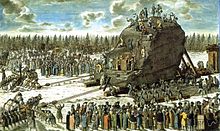Lakhta, Saint Petersburg
You can help expand this article with text translated from the corresponding article in Russian. (October 2018) Click [show] for important translation instructions.
|
59°59′22.20″N 30°09′37.40″E / 59.9895000°N 30.1603889°E
Lakhta (
History

Death of Peter the Great
In the early 18th century,
The story, however, has been viewed with skepticism by some historians, pointing out that the German chronicler Jacob von Stählin is the only source for the story, and it seems unlikely that no one else would have documented such an act of heroism. This, plus the interval of time between these actions and Peter's death seems to preclude any direct link. However, the story may still, in part, contain some grain of truth.

Later history
In 1768, an enormous granite boulder in the nearby forest called the Thunder Stone (Гром-камень) was chosen by
Lakhta has also been a centre of Russian sporting firsts. It was host to Russia's first tennis event, and in 1913 a large building was constructed for the
Lakhta was granted urban-type settlement status and renamed Lakhtinsky (Лахтинский) in 1938. In 1963, it was annexed by Leningrad and became a part of the city.[1]
In 2011
References
- ^ a b c d "Lakhta". Saint Petersburg Encyclopaedia. Retrieved August 28, 2009.
- ^ "Lakhta Center Website, Концепция проекта". Retrieved 2012-08-15.
- ^ "Federal Air Transport Agency Authorization" (PDF). 2011-07-19. Retrieved 2012-08-15.
- ^ "Council on Tall Buildings and Urban Habitat, '100 Future tallest buildings in the world'". Archived from the original on 2012-07-23. Retrieved 2012-08-15.
